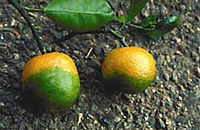
Photo from wikipedia
Huanglongbing (HLB), a devastating disease for citrus worldwide, is caused by Candidatus Liberibacter asiaticus (CLas). In this study, we employed a novel extractive electrospray ionization-mass spectrometry (EESI-MS) method to analyze… Click to show full abstract
Huanglongbing (HLB), a devastating disease for citrus worldwide, is caused by Candidatus Liberibacter asiaticus (CLas). In this study, we employed a novel extractive electrospray ionization-mass spectrometry (EESI-MS) method to analyze the metabolites in leaves of uninfected and HLB-infected Newhall navel orange. The results showed that uninfected and HLB-infected leaves could be readily distinguished based on EESI-MS combined by multivariable analysis. Nine phenolic compounds involved in phenylpropanoid pathways were principal components. Gene expression was also conducted to further exploring the molecular mechanism of phenylpropanoid branch pathway in HLB. The expression of genes (4CL, HCT, CHI, CHS, CYP, and C12R) involved in phenylpropanoid branch pathway increased in asymptomatic and early periods of HLB-infected leaves while decreased in later periods of HLB-infected leaves. This study provides a novel method for early detection of citrus HLB and suggests the regulation mechanism of phenylpropanoid pathway in the interaction between citrus and CLas.
Journal Title: Analytical biochemistry
Year Published: 2021
Link to full text (if available)
Share on Social Media: Sign Up to like & get
recommendations!